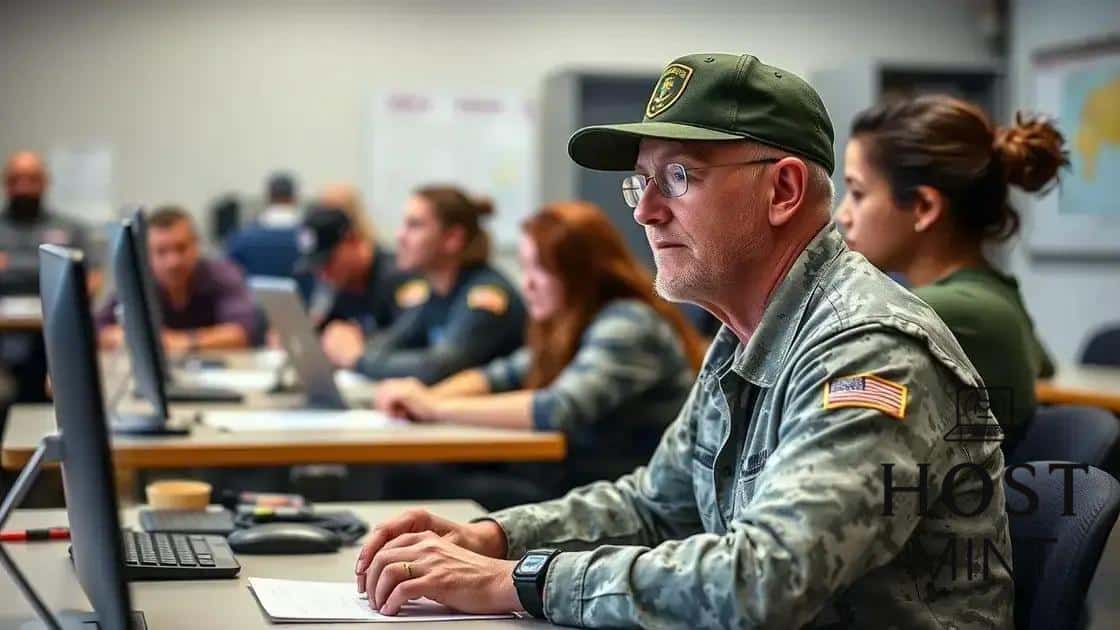Benefits available to veterans with partial disabilities

Benefits available to veterans with partial disabilities include healthcare, financial assistance, educational programs, and vital support networks aimed at enhancing their quality of life and aiding their transition to civilian life.
Benefits available to veterans with partial disabilities can significantly impact their day-to-day lives. From financial support to healthcare services, veterans deserve to know what assistance is out there. Are you aware of the resources available to you or your loved ones?
Understanding partial disabilities for veterans
Understanding partial disabilities for veterans is essential for accessing the right support and benefits. Many veterans face various challenges after serving, which may lead to partial disabilities. Awareness of these issues can significantly improve their quality of life.
What Are Partial Disabilities?
Partial disabilities refer to conditions that limit a person’s ability to perform certain tasks, but do not completely prevent them from functioning. This may include physical issues like mobility challenges or mental health conditions.
Common Types of Partial Disabilities
- Musculoskeletal injuries, such as back pain.
- Neurological conditions, including PTSD.
- Visual and hearing impairments.
- Cardiovascular issues that affect endurance.
Each veteran’s experience with partial disabilities is unique. Understanding these different types can help others provide better support. Many veterans may not realize they qualify for benefits because of their conditions. If you or someone you know is a veteran, it’s important to explore these options.
Symptoms and Daily Impact
Symptoms of partial disabilities can vary widely, affecting daily activities. For instance, someone with a mobility-related disability may struggle with tasks like walking long distances or climbing stairs. Likewise, those with mental health conditions may feel anxious in social situations. Recognizing these challenges helps to provide tailored support.
Many veterans find that connecting with others who have similar experiences can provide comfort. Support groups and community resources offer valuable networking opportunities. Furthermore, veterans can benefit from therapy and counseling sessions that address their specific challenges. Finding the right resources is key to coping effectively.
Living with a partial disability can pose obstacles, but understanding them can encourage veterans to seek assistance. Whether through financial aid, healthcare services, or social support, there are avenues available to help improve their situation. Remember, seeking help is a sign of strength.
Financial assistance programs for veterans
Financial assistance programs for veterans are essential resources that provide support for those in need. Many veterans face financial challenges after serving in the military, and these programs can help ease their burdens. Understanding what is available can empower veterans to improve their financial situations.
Types of Financial Assistance Programs
Several programs exist to assist veterans based on their unique needs. These programs include:
- Disability compensation for service-related injuries.
- Housing assistance for veterans struggling to afford rent or mortgage payments.
- Educational benefits to cover tuition and training costs.
- Emergency financial assistance for unexpected expenses.
Exploring these options is crucial for veterans looking to enhance their financial well-being. For instance, disability compensation can provide critical income for veterans who are unable to work due to their injuries.
Applying for Financial Assistance
The application process for these programs can vary. It often requires documentation of service, medical records, and financial information. Many veterans may find this process overwhelming, but there are resources available. Organizations such as the Veterans Administration and local veteran service organizations can guide veterans through the application process.
Additionally, state governments may offer their own programs. It’s essential for veterans to research and understand both federal and state benefits they may qualify for. Connecting with a benefits counselor can also simplify the process and ensure that all documentation is complete.
Regularly checking eligibility for various programs can lead to additional assistance. Veterans should stay informed about changes in benefits and new programs that may become available. Being proactive about seeking assistance is a significant step toward achieving financial security.
Healthcare benefits for partially disabled veterans
Healthcare benefits for partially disabled veterans play a vital role in their overall well-being. Many veterans are eligible for various healthcare services that can help them manage their health conditions effectively. Understanding these benefits is crucial for accessing the important care they need.
Types of Healthcare Benefits
Veterans often have access to health coverage through the Department of Veterans Affairs (VA). This includes:
- Comprehensive medical care at local VA hospitals.
- Specialized services for mental health issues.
- Rehabilitation programs for physical disabilities.
- Access to prescription medication and assistive devices.
These benefits aim to support veterans in recovering from injuries and managing chronic conditions. The VA also emphasizes preventive care to help veterans maintain their overall health.
Eligibility Criteria
To qualify for these benefits, veterans must meet specific criteria. Generally, those who have been rated with a partial disability by the VA can apply. It is essential for veterans to gather necessary documentation, including their service record and medical evaluations. Knowing how to navigate the application process can lead to a smoother experience.
Furthermore, some veterans may be eligible for additional programs based on their unique situations, such as those related to Agent Orange exposure. Staying informed about possible benefits is crucial for anyone who has served in the military.
Utilizing these healthcare benefits can significantly improve the physical and mental health of partially disabled veterans. Connecting with support groups can also provide valuable insights into maximizing these benefits. Ultimately, understanding and accessing these resources is a key step towards better health and well-being.
Education and vocational training supports

Education and vocational training supports for veterans can drastically change their career paths and empower them in civilian life. Many veterans seek educational opportunities after serving in the military to gain new skills and improve their job prospects. Understanding the available resources is key to maximizing these benefits.
Types of Educational Benefits
Veterans have various options for educational support through programs such as:
- The Post-9/11 GI Bill for tuition and fees.
- Vocational Rehabilitation and Employment (VR&E) services for those with service-connected disabilities.
- Transfer of benefits to family members.
- Online education resources and support programs.
These programs can cover the costs of tuition, housing, and even supplies for veterans pursuing higher education or vocational training. They aim to help veterans transition successfully into the workforce.
How to Access These Benefits
To access these educational benefits, veterans need to apply through the VA. The application process may require documentation detailing military service and educational goals. It is essential for veterans to stay informed about deadlines and requirements. Additionally, schools and training programs often have dedicated staff to assist veterans in navigating these processes.
Many veterans choose to attend community colleges or vocational schools that offer tailored programs for their needs. These institutions provide flexible schedules and small class sizes, which can be crucial for veterans adjusting to student life.
Networking with other veterans and joining local veteran organizations can also provide guidance on the educational resources available. Being proactive about utilizing these supports can lead to achieving personal and professional goals, ensuring a smoother transition into civilian life.
Support networks and community resources
Support networks and community resources are vital for partially disabled veterans. These resources can help veterans navigate challenges after service and build connections with others who understand their experiences. Knowing where to find support can enhance their quality of life.
Types of Support Networks
Veterans can benefit from various support networks, including:
- Local veteran service organizations that offer workshops and counseling.
- Online communities for veterans to share experiences and advice.
- Peer support groups where veterans can connect on a personal level.
- Family and caregiver support programs that provide assistance.
These organizations often offer resources tailored to the specific needs of veterans, making it easier for them to find help and camaraderie.
Finding Community Resources
Community resources can assist veterans with day-to-day living. Many local initiatives focus on helping veterans access:
- Job placement services to aid in career transitions.
- Financial counseling to manage budgets and benefits.
- Healthcare navigation to connect with appropriate medical services.
- Social activities to foster friendships and decrease isolation.
Accessing these resources can truly change a veteran’s life. Organizations like the American Legion and Veterans of Foreign Wars (VFW) provide essential support. Engaging with these groups can lead to valuable friendships and assistance.
Connecting with community resources not only provides practical help but can also reduce feelings of loneliness. Veterans often find strength in unity, learning from one another’s experiences. Being part of a community can motivate veterans to pursue their goals and improve their overall well-being.
FAQ – Frequently Asked Questions about Benefits for Partially Disabled Veterans
What kind of healthcare benefits are available to partially disabled veterans?
Partially disabled veterans can access comprehensive medical care, mental health services, rehabilitation, and prescription medication through the Department of Veterans Affairs.
How can veterans access educational benefits?
Veterans can apply for educational benefits like the Post-9/11 GI Bill to cover tuition and training costs. They need to connect with the VA for assistance in the application process.
What support networks exist for veterans?
There are numerous support networks, including local veteran service organizations, online communities, and peer support groups that offer resources and camaraderie.
How can veterans find community resources for job placement?
Veterans can contact local organizations or the VA for information about job placement services that help them transition to civilian employment successfully.






